The most important facts in brief
- Different types of mallets can be used to produce very different sounds.
- While some mallets are especially suitable for Singing Bowls , other mallets can only be used for gongs, or for both equally.
- The mallet types differ in shape, size and material - all these factors determine which sound is produced with the mallet.
- In this article, you will find out what types of mallets are available, what they are particularly suitable for and how you can get the most out of the sounds.
What is a mallet?
In order to understand the different types of mallets, we would first like to take a look at their origins. Traditionally, a Singing Bowl was played with a simple wooden stick. Occasionally, glass mallets were also used to achieve an even greater variety of sounds.
It was discovered early on that mallets with a soft surface produce lighter vibrations and can therefore produce very gentle and long sounds. People began to cover wooden mallets with soft leather in order to produce particularly pleasant sounds. Today, mallets are generally no longer covered with leather, as there are now much softer materials that allow for an even more diverse sound spectrum.
How is a mallet constructed?
Among the different types of mallets, there are a large number of differently shaped models. However, the basic structure is always the same: a mallet consists of a handle, shaft and head. The heads of mallets for gongs and Singing Bowls are often made of caoutchouc, felt or fleece - or several materials are combined. The handle is usually made of a robust material, for example wood or aluminum, or is covered with a haptically pleasant layer that ensures a good grip. The shaft is often made of the same material.
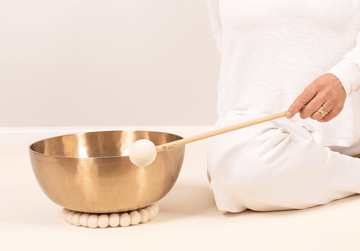
Note
The shape of the mallet depends primarily on its size: The smaller and harder the mallet is, the higher the tone that is produced when playing a Singing Bowl or a gong. Accordingly, a larger mallet is used for low notes. The duration of the sound and the volume are also directly related to the size of the mallet.
What types of mallets are there?
Mallets don't just differ in shape and material - most mallets are made specifically for certain instruments. In our article, we would like to give you an overview of the special mallets for Singing Bowls and mallets for gongs. However, many other instruments are also played with a mallet - including drums, percussion instruments and timpani, for example. Accordingly, there is also a wide variety of mallet types.
Felt mallets and fabric mallets
Felt mallets are characterized above all by the harmonious tone that can be produced by the relatively soft felt material. The softer the felt ball, the softer and deeper the tone produced by chime . The different sizes and degrees of hardness of the felt make it possible to produce sounds that are sometimes more voluminous and powerful, sometimes gentler and softer.
In the sound exercise in the following video you can hear the sound of a soft felt mallet and get inspiration for a daily ritual with a Singing Bowl.
Tip
Felt mallets are particularly suitable for playing Singing Bowls. The light weight, which is characteristic of felt mallets, is an advantage. Several Singing Bowls can also be played at the same time with a felt mallet. The sound that is produced in the end depends not only on the hardness of the felt mallet, but of course also on the Singing Bowl itself.
Particularly soft felt mallets should be used for thin-walled Singing Bowls in order to achieve the most harmonious sound possible. Thick-walled Singing Bowls , on the other hand, are played with harder felt mallets.
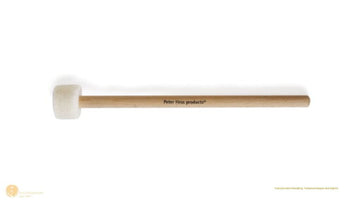
Rubber mallets
A major advantage of the rubber mallet is the high level of hygiene that can be ensured by the natural rubber or rubber head. Rubber mallets are therefore very often used in the therapeutic field of sound therapy in particular, where strict hygiene regulations must be observed. But there are also good acoustic reasons for using a rubber mallet: it is used for both rubbing and percussion techniques and therefore offers a wide range of different pitches.
The caoutchouc head is attached to a round handle, which is usually made of soft wood to make it easy to bend and flexible. If you use rubber mallets for strike from Singing Bowls, the result is a very clear, soft sound. If you decide to use the rubber mallet as a reamer instead, you can run it along the edge of the Singing Bowl to produce a continuous and intense sound.
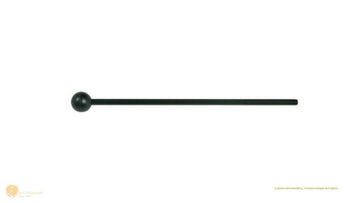
Aluminum mallets
Aluminum is considered one of the lightest metals and is therefore also very popular in sound therapy. Aluminum mallets have a very low weight, which in turn allows you to play for long periods of time. The hygienic aspect is also very important, as the metal can be easily disinfected and can therefore also be used in a therapeutic context.
Acoustically, aluminum mallets offer a very unique sound. The room-filling sound of the aluminum mallet depends not only on the material of the handle, but also on the head. Most aluminum mallets have a rubber or felt head, which influences the sound in different ways.
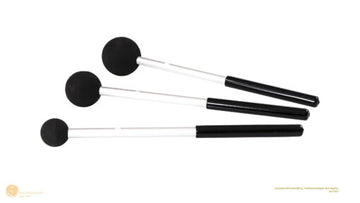
Gong mallets
Many mallets are specially designed for playing a Singing Bowl . A gong mallet (also known as a gong mallet), on the other hand, is specially developed for use on a gong. The gong mallet is also constructed like a typical mallet and consists of a handle, which is usually made of wood, and a head, which is often made of felt, caoutchouc, fleece or fabric - or a combination of several materials.
Different sounds are produced depending on where the gong mallet is used on the gong. Gong mallets are available in numerous variants, differing not only in their materials but also in their sizes.
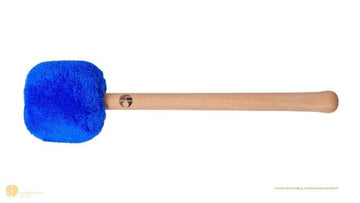
Gong friction mallets
Compared to a gong mallet, the gong reamer is usually shorter and therefore easier to handle. While the strike of the gong produces very lively and powerful tones, a gong reamer can produce a more sustained and persistent tone that directly affects the listener with bright and deep nuances.
A gong driver should always meet the highest quality standards, otherwise the gong may be damaged or soiled. When selecting the material, make sure that the head of the gong driver is made of the softest possible material that does not leave any residue on the gong.
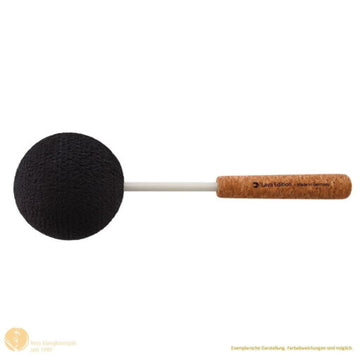
Singing bowl friction mallets
As the name suggests, a reamer produces sound through friction. Compared to the classic strike , rubbing a Singing Bowl requires a little more practice.
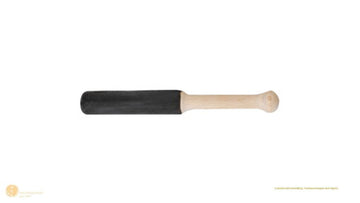
Tip
If you want to produce long-lasting and almost "singing" sounds, then the reamer is exactly the right choice. The larger your Singing Bowl is, the easier it will be for you to achieve the desired sounds with the reamer.
However, it's not just your Singing Bowl that matters, but also the material the grater is made of. A wooden handle and a rather hard head made of felt or chewy suk, for example, are typical for a rubbing mallet. Some rubbers for gongs and Singing Bowls are also covered in textile leather.
But be careful: when buying a singing bowl rubbing stick, you should always make sure it is of high quality, otherwise scratches or other damage to the Singing Bowl may result. In our article, we explain how you should clean and care for your Singing Bowl in order to produce beautiful sounds with a singing bowl recorder for as long as possible.
What is the difference between a mallet and a grater?
Singing Bowls and gongs can be played with a mallet or a reamer to produce a variety of sounds. However, the sound differs greatly between the two variants - which is why specially developed mallets or graters are used for both playing methods.
In most cases, a mallet is longer than a friction mallet in order to generate enough energy to produce a powerful sound. While the mallet is used for strike Singing Bowls or gongs, the reamer is used for the softer tones, which last much longer in comparison. The gong in particular produces very characteristic tones that remind us of whale song. a friction mallet is used to run over the instrument to produce a very long and intense sound. You can find out more in our article about the differences between mallets and rubbers.
Which mallets are especially suitable for Singing Bowls and which are especially suitable for gongs?
The differences are manifold: mallets for gongs are in most cases much longer and easier to grip than mallets for Singing Bowls, which is not least due to the size of a gong. However, the energy required to strike a gong is also significantly higher due to its size - and a longer gong mallet is also recommended for this reason. With a Singing Bowl , on the other hand, the most important thing is to work with a mallet that is as light as possible to enable smooth chime playing. This is why the handles are not only shorter, but also usually made of lighter wood.
Mallets for gongs, on the other hand, are not only longer, but in some cases also have a much more voluminous head. In terms of material, the two mallets and rubbers are not as different as you might think - felt heads or rubber heads are also used on a gong mallet to produce a beautiful sound. However, while most mallets for Singing Bowls only have one head on the mallet, double-sided mallets are often used for gongs. These types of mallets have a head at both ends of the handle to enable a double chime sound.
How do you find the right mallet for you?
If you want to buy a mallet, you should consider in advance which mallets are suitable for your Singing Bowl or your gong. Depending on the material you choose, characteristic sounds are created that are all unique, but not necessarily suitable for you.
External factors also play a role: if you want to use the mallet in a therapeutic context, strict hygiene regulations must be observed. We recommend using a material that can be thoroughly disinfected without causing any damage. Simply browse through our range to find the right mallet for your individual needs.






